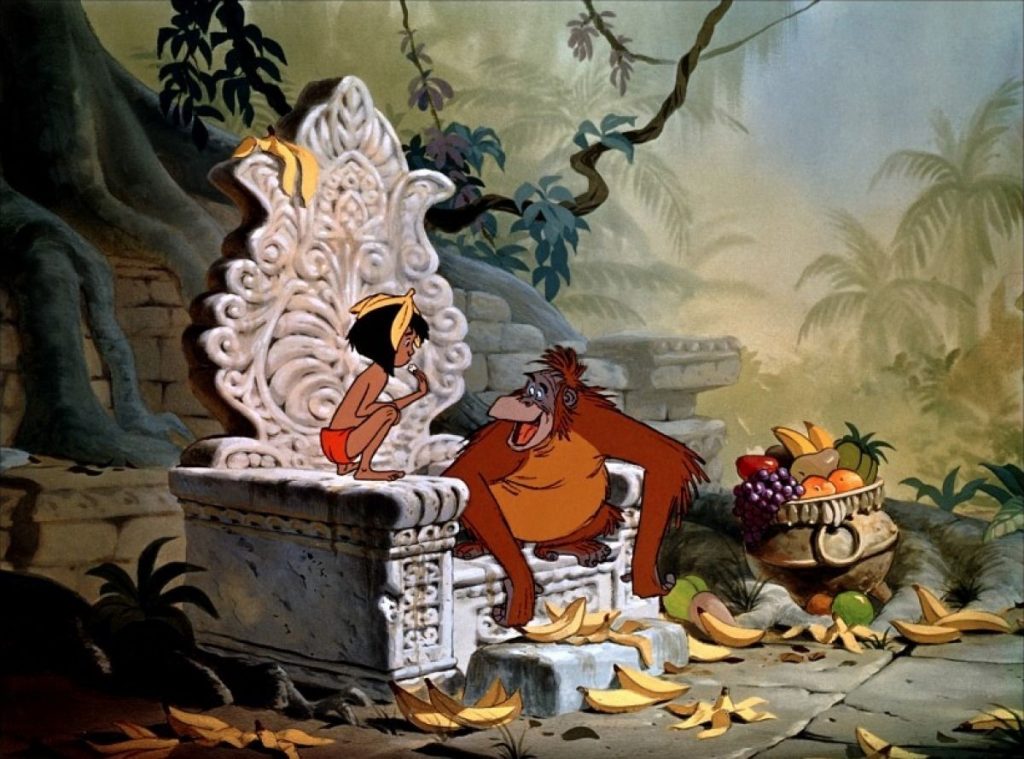James Fargo’s 1978 film Every Which Way but Loose follows Clint Eastwood’s character Philo Beddo and his orangutan companion Clyde in their search for love. The audience’s expectations of human-animal relationships depicting docile animals who are human playthings are immediately subverted by Philo’s interactions with Clyde, the orangutan.

Figure One 
Figure Two
Clyde throughout the film is given a freedom not afforded other orangutans. Figure three illustrates the typical fate that befalls an orangutan when they come into close contact with humans. It is important to note that some but not all orangutans are kept imprisoned in cages and poached whilst their habitats are subject to widespread deforestation and wildfires. Earlier in the film, it is discussed that Clyde is a Sumatran orangutan who was kept in a cage until Philo emancipated him. As Wich observes, the Sumatran rainforest has been destroyed by humans for monetary reasons such as palm oil and poaching.[1] This destruction of Clyde’s homeland demonstrates the lack of care some humans have for the natural world. The scene being examined illustrates the Orangutan-Human camaraderie that can thrive given the correct nurturing and demonstrates how orangutans are viewed as compatriots to humanity.

The relationship between human-animal forms the basis of the above scene; which shows Clyde and Philo’s drunken montage as they go about their night. Clyde in this scene exhibits anthropomorphic traits such as his ability to use the jukebox in the restaurant illustrating his high intelligence and dexterity; Clyde’s reaction afterwards shows him moving his finger around in a similar way to how a human might tap along to their favourite songs; signifying Clyde’s human-like appreciation of art. The Mise-en-scene here is extremely important. Clyde has eagerly chosen the music in the restaurant and now the audience is at the whims of his choice; this is because the music has now become diegetic and underscores Philo and Clyde’s actions in the scene that follows. A medium-length tracking shot follows their actions down a street and the scene employs fade-in editing to show the passage of time for the characters. Moreover, Clyde and Philo walk hand in hand with the romantic music playing over their actions. The audience during this scene is never given a POV shot from either Clyde or Philo’s point of view, demonstrating we are voyeurs in their relationship. Clyde here is presented as a friend of Philo and is protected by Philo throughout the film when any harm could potentially come to him. This shows the ability humans have to conserve orangutan’s lives when they desire to. Clyde as Philo’s companion is removed from the destructive rainforest environment which blights some of his fellow orangutans lives and enjoys a comfortable life typically reserved for people.

Figure Four 
Figure Five
The drunken montage is a clichéd trope; however, it is the inclusion of Clyde that subverts it. This is because of how the director frames Clyde and Philo’s interactions in the scene. Philo and Clyde share a drink and visit a strip club. The patrons in the strip club are more focused on the women than the fact an orangutan is sitting next to them drinking alcohol. The camera in this scene is stationary and situated behind the bar with a focus on Clyde and the human patrons surrounding him. This allows the viewer to fully realise all of Clyde’s movements and serves to put him on a comparable footing with everyone around him. Clyde also takes on a voyeuristic role here illustrating that the distinction between humans and animals is not as blurred as typically suggested. This is demonstrated by Clyde’s prolonged staring at the female strip teaser in front of him and Clyde leaning back in this scene slightly as Philo blocks his view of her. Clyde wishes to see more of the dancer without his view interrupted much like a human observer of a strip club would. Moreover, Clyde throughout the scene acts as a confidante for Philo who can trust Clyde implicitly and vent his frustrations and failures upon a sympathetic Clyde. This is Clyde demonstrating his value as a homosocial surrogate figure for Philo who is not in a relationship or marriage with a female but still wishes to form bonds with another individual animal or otherwise. Clyde’s interaction with Philo during this scene is lighthearted and illustrates a cross-species bond which echoes Human-Animal interactions portrayed in other film’s such as Mowglis’s interaction with King Louie in the Jungle Book.

Figure Six
Clyde throughout the scene provides a catharsis for Philo and acts as a salve for his troubles. The scene demonstrates the impact humans and animals positively have on each other. Clyde is far removed from the Sumatran rainforest and his habitat; but still visibly displays enjoyment in his human interactions.
Bibliography
Bednar, Cheryl, Geoffrey Lewis with Clint Eastwood (and Clyde) Every Which Way But Loose and Every Which Way You Can, digital photograph, Pinterest, [n.d.] <https://www.pinterest.co.uk/pin/251286854185441297/> [accessed 12 November 2022]
Clinteastwoodfans01, Clint and Clyde, digital photograph, Instagram, 24 March 2020 <https://www.instagram.com/p/B-IREzvnDwa/?igshid=17249kmf3kl0l> [accessed 11 November 2022]
Every Which Way But Loose, channel 5, 2 August 2014, 14:55pm, <https://learningonscreen.ac.uk/ondemand/index.php/prog/01272951?bcast=113642666> [accessed 11 November 2022]
Film Fanatic, Film Disney The Jungle Book (1967), digital photograph, Pinterest, [n.d.] <https://www.pinterest.co.uk/pin/the-jungle-book-1967–487936940849386416/> [accessed 7 January 2023]
Ifansasti, Ulet, digital photograph, Insider, 11 March 2020, <https://www.insider.com/photos-orangutans-struggle-survive-poaching-deforestation-2020-2#the-biggest-threat-is-habitat-loss-from-deforestation-borneo-and-indonesia-or-what-used-to-be-called-emerald-of-the-equator-have-some-of-the-most-untouched-rainforests-in-the-world-but-massive-amounts-have-been-cleared-for-palm-oil-32> [accessed 11 November 2022]
Jimpsterz, Charlie Rich – I’ll Wake You Up When I get home. – Every which way but loose, online video recording, YouTube, 16 July 2010, <https://www.youtube.com/watch?v=NkQihnrjlhk> [accessed 11 November 2022]
Jones, Craig, digital photograph, Insider, 11 March 2020, <https://www.insider.com/photos-orangutans-struggle-survive-poaching-deforestation-2020-#theyre-also-kept-as-pets-by-locals-some-see-owning-a-great-ape-as-a-status-symbol-while-other-locals-eat-them-31> [accessed 11 November 2022]
Novis, John, digital photograph, The Guardian, 6 October 2009, <https://www.theguardian.com/environment/gallery/2009/oct/06/deforestation-sumatra-redd> [accessed 11 November 2022]
Wich, Serge and others., ‘Land-cover changes predict steep declines for the Sumatran orangutan (Pongo abelii)’, Science advances, 2.3 (2016), 1-8 (p.1) <http://dx.doi.org/doi:10.1126/sciadv.1500789>
Foot Notes
[1] Serge Wich and others. ‘Land-cover changes predict steep declines for the Sumatran orangutan (Pongo abelii)’, Science advances, 2.3 (2016), 1-8 (p.1) <http://dx.doi.org/doi:10.1126/sciadv.1500789>.